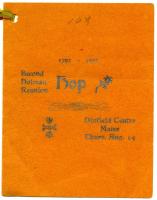
The Holman Family reunion and homestead, Dixfield, ca. 1911
Dixfield Historical Society
DIXFIELD COMMON (CENTER)
The First Section to be Settled
Even in absentia, the influence of Col. Jonathan Holman was felt throughout the town. His sons settled in that part called the Common, and its location approximated the center of the township. An old saying by the locals states that there is a rock located somewhere on the Peter Holman property that designates the exact center of town.
Beginning with the first town meeting held at the home of Levi Newton, and then shortly after at the home of Peter Holman, town affairs were conducted here. Dixfield citizens traveled from all points of the town to hold a day-long gathering to vote on important elected positions of the town and to discuss the building of roads. Selectmen, Town Clerk, and Tax Collector, Bondsmen, Road Surveyors, Hog Reaves and other positions were elected to see that the town would be on stable footing for the coming year. Women did not have the right to vote at that time, so the men conducted the meetings and were elected to all offices. The women and children provided hearty meals at the meetings.
Waits, Whites, Newmans, Delanos, Tainters, Newtons, Fosters and Kenneys lived alongside the Holmans and contributed to the area’s agricultural life. The Holmans with their large land holdings at the center of town predominated, however. Even today many of the town’s people take special pride in claiming the Holmans as their ancestors. Peter Holman’s legacy lives on through his great-grandsons, Peter and Robert, great-granddaughter Geraldine and others who have generously shared information about the old lore of the land.

Dance Program for the Second Holman Reunion, Dixfield Centre, 1902
Dixfield Historical Society
Col. Jonathan Holman was a frequent visitor to Holmantown to “visit his boys down in Maine.” According to the History of the Town Sutton, Massachusetts by the Reverends W. Charles Benedict and Hiram Averill Tracy (1878), he always rode in the saddle, and his rule was to ride seventy miles a day. He had a powerful, high-sprited horse which he called his “War Horse” which was never broken to harness and could be managed by none but himself. At the age of seventy-five years old, he could vault into the saddle as lightly as a boy!
In addition to agriculture, Holmantown pioneers raised cattle, sheep and small farm animals and supplemented food supplies from the wild lands that surrounded their farms. Hunting wild game and trapping were also important jobs for daily survival. Berrying in the summer was an annually awaited event. According to local historian Ruth Kidder:
Often the team was harnessed and the wagon filled for a trip to White Cap in neighboring Rumford. This was the most famous berrying place around and bushels of berries were harvested there each summer. The pastures behind Kenneth Newman and Bernard Kidder were locally famous blueberrying spots, as were the Sugar Loaves. From the start of the strawberry season, through blueberries, raspberries and blackberries, the women were busily filling every container.
Today the Common is mostly considered rural living with few agricultural establishments. Although not considered the center of town, its residents still raise a healthy voice in all town affairs and guard the esthetic and historical value of the land. Peter Holman and his wife Mercy (Knight) are buried in the Holman Cemetery that can be reached by crossing private land of Holman descendants on the Common Road. The large slate headstone is engraved with a willow tree and an epitaph and reads:
Peter Holman
Born October 16, 1769 in Sutton, Massashusetts
Married Mercy Knight of Peru, Maine in 1796
Died October 30, 1829 at Dixfield at the age of 60